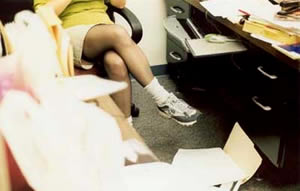 | |
| { Each Woman Here Had Opted for the Nylons } Leslie Hoffman
While hosiery has been around since the time of the Egyptians, silk stockings weren't invented until the weaving technology arrived in Europe in the 1500s, and panty hose didn't come into style until the 1960s. Sid Smith, president and CEO of the National Association of Hosiery Manufacturers, provides a history of hosiery—including the invention of panty hose—on the Web site Bluechipsocks.com. After panty hose entered my world, I transitioned from being in awe of these nylon tubes to being annoyed by them. By the time I was in high school a steady supply of fashion magazines full of stories and photographs of glamorous models tripping about New York, sans nylon, fueled my literary diet. I wondered how they stood the bitter cold of the North East protected only by a glittering sandal, but I figured if Vogue said it was okay, it was. So I started asking women who work in offices what they think of panty hose. Most of them were more than a little shocked. That seems to be the consensus with working women: They endure panty hose for the workday and shed them when they're having fun. And maybe that's where the passage to adulthood enters—it's something greater than merely looking like one. | |
 When I think of panty hose, I always imagine the curvy, foreboding leg that teases a young Dustin Hoffman on the famous movie still for The Graduate. Just like that silk-clad leg promised a lesson in adulthood for the young Benjamin Braddock, thin and silky hosiery is just one more step for girls on the pathway to adulthood and the sophistication that is sure to follow.
When I think of panty hose, I always imagine the curvy, foreboding leg that teases a young Dustin Hoffman on the famous movie still for The Graduate. Just like that silk-clad leg promised a lesson in adulthood for the young Benjamin Braddock, thin and silky hosiery is just one more step for girls on the pathway to adulthood and the sophistication that is sure to follow.